The following material has been sourced from the Australian Institute of Health and Welfare
Lymphoma incorporates ICD-10 cancer codes C81 (Hodgkin’s disease), C82 (follicular non-Hodgkin’s lymphoma), C83 (diffuse non-Hodgkin’s lymphoma), C84 (peripheral and cutaneous T-cell lymphomas) and C85 (other and unspecified types of non-Hodgkin’s lymphoma).
New cases
In 2018, non-Hodgkin lymphoma was the sixth most commonly diagnosed cancer in Australia. It is estimated that it will remain the sixth most commonly diagnosed cancer in 2022. Non-Hodgkin lymphoma makes up approximately 90% of lymphoma cases in Australia.
In 2018, there were 6,438 new cases of lymphoma diagnosed in Australia (3,735 males and 2,702 females). In 2022, it is estimated that 7,397 new cases of lymphoma will be diagnosed in Australia (4,267 males and 3,130 females). In 2022, it is estimated that a person has a 1 in 40 (or 2.5%) risk of being diagnosed with lymphoma by the age of 85 (1 in 35 or 2.9% for males and 1 in 48 or 2.1% for females).
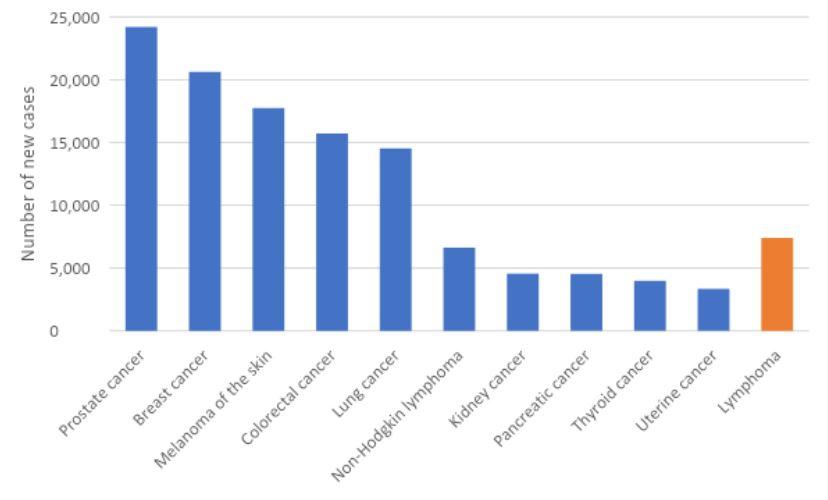
Notes
- Data sourced from AIHW Cancer Data in Australia 2022 web report and supplementary data tables
- More information about incidence rates for the most common cancers diagnosed can be found on the NCCI website in the ‘Cancer incidence’ section (https://ncci.canceraustralia.gov.au/diagnosis/cancer-incidence/cancer-incidence)
In 2018, the age-standardised incidence rate was 22 cases per 100,000 persons (27 for males and 18 for females). In 2022, it is estimated that the age-standardised incidence rate will be 23 cases per 100,000 persons (28 for males and 19 for females). The incidence rate for lymphoma is expected to increase with age, highest for those aged 80–84 years.
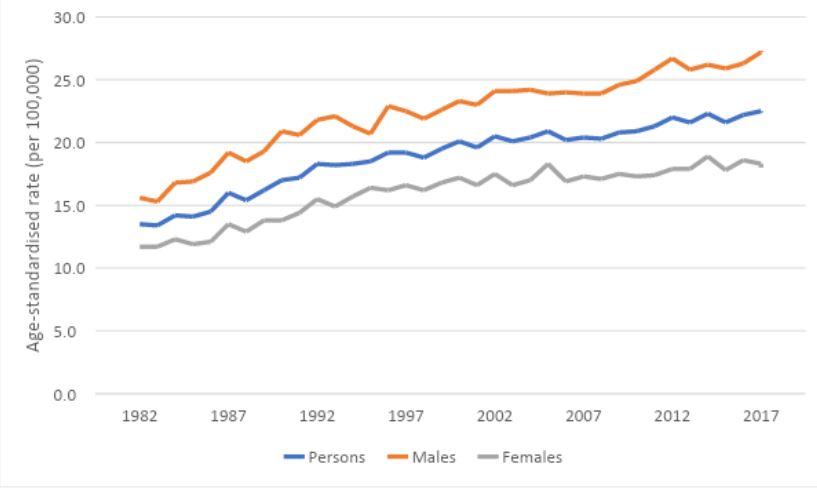
Notes:
- Data sourced from AIHW Cancer Data in Australia 2022 web report and supplementary data tables
- More information about incidence rates for the most common cancers diagnosed can be found on the NCCI website in the ‘Cancer incidence’ section (https://ncci.canceraustralia.gov.au/diagnosis/cancer-incidence/cancer-incidence)
The number of new cases of lymphoma diagnosed increased from 1,745 (937 males and 808 females) in 1982 to 6,438 in 2018. Over the same period, the age-standardised incidence rate increased from 14 cases per 100,000 persons (16 for males and 12 for females) in 1982 to 22 cases per 100,000 in 2018.
Deaths
In 2020, non-Hodgkin lymphoma was the eighth most common cause of cancer death in Australia. It is estimated that it will remain the eighth most common cause of death from cancer in 2022.
In 2020, there were 1,679 deaths from lymphoma in Australia (961 males and 718 females). In 2022, it is estimated that there will be 1,766 deaths (1,017 males and 749 females). In 2022, it is estimated that a person has a 1 in 185 (or 0.54%) risk of dying from lymphoma by the age of 85 (1 in 157 or 0.64% for males and 1 in 227 or 0.44% for females).
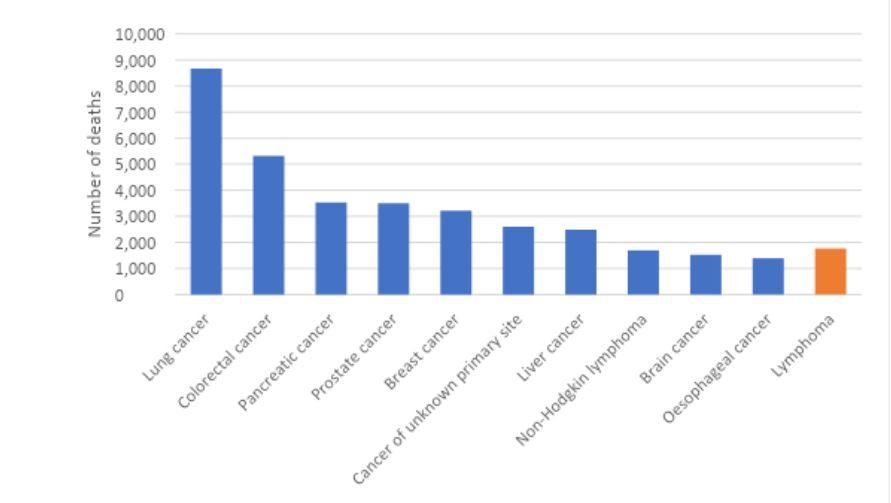
Notes
- Data sourced from AIHW Cancer Data in Australia 2022 web report and supplementary data tables
- More information about mortality rates for the most common causes of cancer death can be found on the NCCI website in the ‘Cancer mortality’ section (https://ncci.canceraustralia.gov.au/outcomes/cancer-mortality/cancer-mortality)
In 2020, the age-standardised mortality rate was 5.2 deaths per 100,000 persons (6.5 for males and 4.0 for females). In 2022, it is estimated that the age-standardised mortality rate will be 5.1 deaths per 100,000 persons (6.4 for males and 3.9 for females). The mortality rate for lymphoma is expected to increase with age.
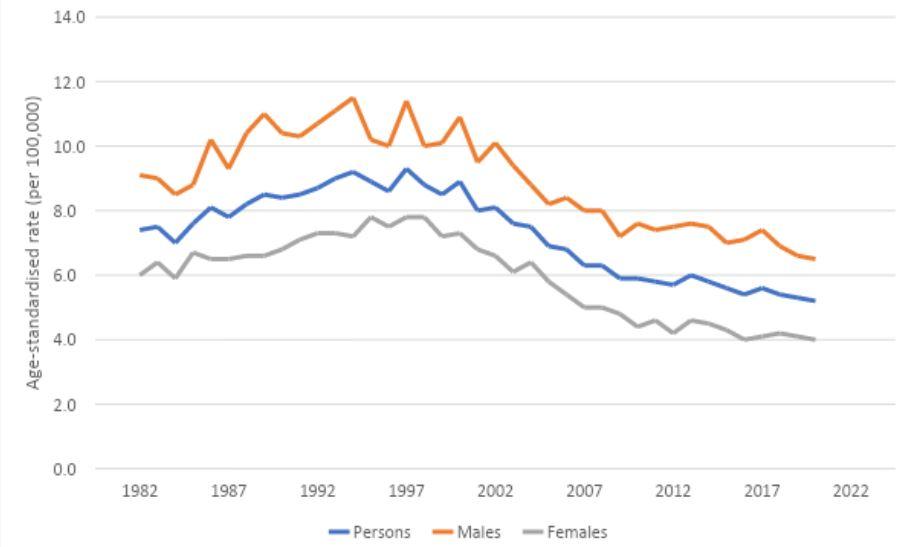
Notes:
- Data sourced from AIHW Cancer Data in Australia 2022 web report and supplementary data tables
- More information about mortality rates for lymphoma over time, by age, sex, Indigenous status, remoteness, and socioeconomic status (SES) can be found on the NCCI website in the ‘Cancer mortality’ section (https://ncci.canceraustralia.gov.au/outcomes/cancer-mortality/cancer-mortality)
The number of deaths from lymphoma increased from 918 (509 males and 409 females) in 1982 to 1,679 in 2020. Over the same period, the age-standardised mortality rate remained similar from 7.4 deaths per 100,000 persons (9.1 for males and 6.0 for females) in 1982 to 5.2 deaths per 100,000 in 2020.
Survival
In 2014–2018, individuals diagnosed with lymphoma had a 78% chance (76% for males and 79% for females) of surviving for five years compared to their counterparts in the general Australian population. Between 1989–1993 and 2014–2018, five-year relative survival for lymphoma improved from 54% to 78%.
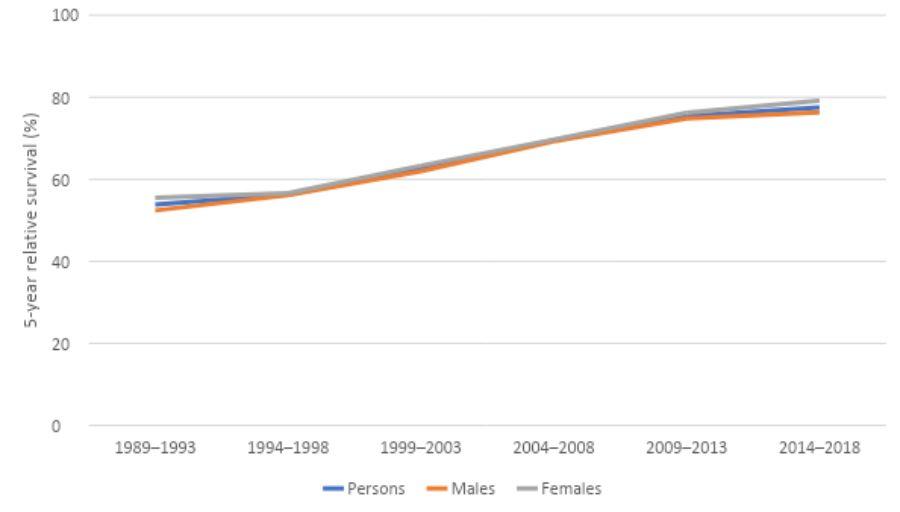
Notes:
- Data sourced from AIHW Cancer Data in Australia 2022 web report and supplementary data tables
- More information about 5-year relative survival rates for lymphoma over time, by age, sex, Indigenous status, remoteness, and socioeconomic status (SES) can be found on the NCCI website in the ‘Relative survival rate’ section (https://ncci.canceraustralia.gov.au/outcomes/relative-survival-rate/5-year-relative-survival-diagnosis)
Prevalence
At the end of 2017, there were 5,702 people living who had been diagnosed with lymphoma that year, 23,141 people living who had been diagnosed with lymphoma in the previous 5 years (from 2013 to 2017) and 62,378 people living who had been diagnosed with lymphoma in the previous 36 years (from 1982 to 2017).
For more information, see Lymphoma on the NCCI website
The National Cancer Control Indicators (NCCI) are a set of indicators across the continuum of cancer care, from Prevention and Screening through to Diagnosis, Treatment, Psychosocial care, Research and Outcomes. The NCCI website allows users to see visual representations of data on each indicator through interactive charts.

